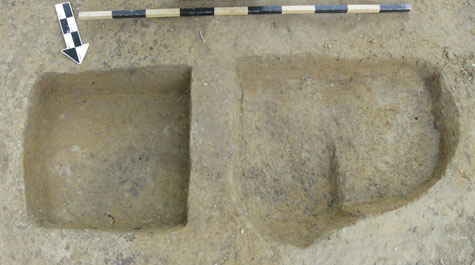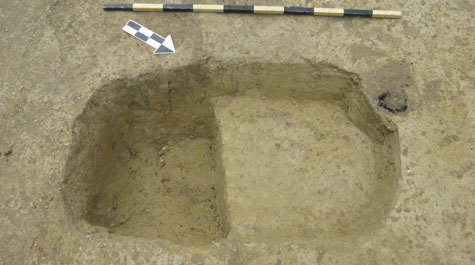Bone fragments from historic-period graves discovered on W&M campus
The graves, which contain tiny bone fragments that have been incorporated into the soil matrix, were discovered July 13 by the William & Mary Center for Archaeological Research (WMCAR). The burial sites were found under the east end of James Blair Drive between the King and Queen Gate and the rear of Tucker Hall. WMCAR was doing advance testing in the area prior to construction work on the Historic Campus, which dates from the 1693 founding of the College.
"We found two separate burials of very young children, possibly infants," said Joe Jones, director of WMCAR, adding that the condition of the fragments is such that they cannot be separated from the soil. "The bone fragments in each grave are very small - and together would fit in the palm of your hand - but circumstantial evidence such as the size, soil and orientation tell us these are human graves."
The College is working closely with the Virginia Department of Historic Resources (VDHR) and is in the process of applying to the state for removal of the remains. Once removed, Jones said, they would be given to the state for final disposition.
Jones and the WMCAR staff have been coordinating efforts with a construction crew installing piping for a new heating and cooling system for buildings in the College's old and Historic Campus. Their task has been to assess the archaeological significance of the areas being excavated prior to construction.
"Discoveries such as these are why we take such a tremendous amount of care whenever we are planning a project that may disturb the ground on the Historic Campus," said Vice President for Administration Anna Martin, adding work on the piping project will not begin in this area until the bone fragments have been removed. "These graves are so small and the bone fragments so hard to distinguish to an untrained eye, we are fortunate to have professionals like Joe Jones and his staff to assist these efforts."
Jones said the graves are from the historic period-since the time of European settlement - but conditions make it virtually impossible to determine who they belonged to or exactly when the burials occurred. For example, the children were not buried in coffins or any type of burial container. The sites are about 10 feet apart. Both graves are about two feet below the present-day ground surface.
Relevant records from the era of the burials are rare, though Jones noted that a Revolutionary War-era map shows a building in the vicinity of the gravesite.
"That, coupled with a high density scatter of eighteenth-century domestic and architectural artifacts we found nearby- ceramics, bottle glass, nails, brick fragments and such-made us aware that there might be something of archaeological significance beneath this portion of James Blair Drive," he said. "But we certainly didn't expect to discover human remains."
Jones has been with WMCAR since 1988 and says that this is the first instance of unidentified, unmarked human remains being discovered on the Historic Campus.
He said WMCAR routinely does archaeological assessment work in conjunction with construction, especially when the artifact-rich ground of the Historic Campus is involved. "The College has been here a long time," Jones said. "In addition, people lived here before the College. People lived here before Williamsburg. This portion of the campus is basically one large archaeological site comprising overlapping areas and scatters of archaeological resources representing multiple periods of occupation and activity during the historic period."
















